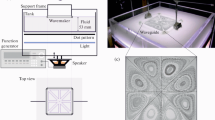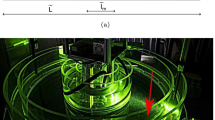Abstract
Pattern formation in forced surface waves occurs between two layers of immiscible fluids of different densities, in which a vertical vibration is imposed, leading to stationary waves. This experimental study focuses primarily on the formation of the various wave patterns (solitary waves and meniscus waves) and the onset of Faraday waves. Three control parameters are varied to produce different flow patterns: the forcing amplitude and frequency as well as the depth (Af, ωf, Γ). In this paper, we investigate low forcing frequencies ranging from 3 to 5 Hz, and high forcing amplitudes ranging from 3 to 15 mm. The measured responses correspond to the oscillation frequencies of the free surface ωs and their associated wavelength λs. It is found that a succession of equilibrium states occurs spatially periodic structures and symmetric up to well-defined thresholds. Beyond these thresholds, symmetrical structures are broken and may follow two different paths: chaos follows the onset of the cross of Saint Andrew (meniscus wave) occupying all of the diagonal or an unstable pattern in the form of an odd polygon.










Similar content being viewed by others
Abbreviations
- A f :
-
Forcing amplitude (mm)
- A + :
-
Relationship between Af and h (A+ = Af / h)
- h :
-
Fluid depth (mm)
- H :
-
Container height (mm)
- l :
-
Square container width (mm)
- L c :
-
Container characteristic length (mm)
- r f :
-
Forcing ratio rf = ωf / ωmax imposed on the flow system
- r ω :
-
Frequencies ratio rω = ωs / ωf associated with surface waves
- N* :
-
New dimensionless number
- St:
-
Stokes number
- We:
-
Weber number
- Γ :
-
Filling ratio Γ = Lc / h
- θ :
-
Fluid temperature (°C)
- λ * :
-
Dimensionless surface wavelength
- ν :
-
Kinematic viscosity (m2/s)
- ρ :
-
Fluid density (kg/m3)
- σ :
-
Surface tension (N/m)
- ω f :
-
Forcing frequency (rd/s)
- ω max :
-
Maximum forcing Frequency ωmax = 28.48 rd/s
- ω s :
-
Vibration frequency of free surface (rd/s)
References
M. Faraday, Philos. Trans. R. Soc. London 121, 299–340 (1831). http://www.jstor.org/stable/107936
L. Rayleigh, Philos. Mag. 15, 229–235 (1883). https://doi.org/10.1080/14786448308627342
L. Rayleigh, Philos. Mag. 16, 50–58 (1883). https://doi.org/10.1080/14786448308627392
T.B. Benjamin, F. Ursell, Proc. R. Soc. Lond. 225, 505–515 (1954). https://doi.org/10.1098/rspa.1954.0218
S. Ciliberto, J.P. Gollub, J. Fluid Mech. 158, 381–398 (1985). https://doi.org/10.1017/S0022112085002701
S. Douady, S. Fauve, Europhys. Lett. 6, 221–226 (1988). https://doi.org/10.1209/0295-5075/6/3/006
S. Douady, J. Fluid Mech. 221, 383–409 (1990). https://doi.org/10.1017/S0022112090003603
S.P. Das, E.J. Hopfinger, J. Fluid Mech. 599, 205–228 (2008). https://doi.org/10.1017/S0022112008000165
W. Batson, F. Zoueshtiagh, R. Narayanan, J. Fluid Mech. 729, 496–523 (2013). https://doi.org/10.1017/jfm.2013.324
J. Rajchenbach, A. Leroux, D. Clamond, Phys. Rev. Lett. 107, 024502 (2011). https://doi.org/10.1103/PhysRevLett.107.024502
J. Rajchenbach, D. Clamond, A. Leroux, Phys. Rev. Lett. 110, 094502 (2013). https://doi.org/10.1103/PhysRevLett.110.094502
N.B. Tufillaro, R. Ramshankar, J.P. Gollub, Phys. Rev. Lett. 62, 422–425 (1989). https://doi.org/10.1103/PhysRevLett.62.422
B. Christiansen, P. Alstrom, M.T. Levinsen, Phys. Rev. Lett. 68, 2157–2161 (1992). https://doi.org/10.1017/S0022112095002722
W.S. Edwards, S. Fauve, Phys. Rev. E 47(2), R788–R791 (1993). https://doi.org/10.1103/PhysRevE.47.R788
H.W. Muller, Phys. Rev. Lett. 71, 3287–3290 (1993). https://doi.org/10.1103/PhysRevLett.71.3287
A. Kudrolli, B. Pier, J. P. Gollub, Physica D, 123, 99–111 (1998). https://doi.org/10.1016/S0167-2789(98)00115-8
A. Kudrolli, J. P. Gollub, Physica D, 97, 133–154 (1996). https://doi.org/10.1016/0167-2789(96)00099-1
A. B. Ezerskii, M. I. Rabinovich, V. P. Reutov, I. M. Starobinets, Transl. Sov. Phys. JETP 64, 1228–1236 (1986). http://jetp.ac.ru/cgi-bin/dn/e_064_06_1228.pdf
D. Binks, M.T. Westra, W. Van Der Water, Phys. Rev. Lett. 79, 5010–5013 (1997). https://doi.org/10.1103/PhysRevLett.79.5010
O. Lioubashevski, H. Arbell, J. Fineberg, Phys. Rev. Lett. 76, 3959–3962 (1996). https://doi.org/10.1103/PhysRevLett.76.3959
A.V. Kityk, J. Embs, V.V. Mekhonoshin, C. Wagner, Phys. Rev. E 72, 036209 (2005). https://doi.org/10.1103/PhysRevE.72.036209
F. Simonelli, J.P. Gollub, J. Fluid Mech. 199, 471–494 (1989). https://doi.org/10.1017/S0022112089000443
K. Kumar, L.S. Tuckerman, J. Fluid Mech. 279, 49–68 (1994). https://doi.org/10.1017/S0022112094003812
J. Bechhoefer, V. Ego, S. Manneville, B. Johnson, J. Fluid Mech. 288, 325–350 (1995). https://doi.org/10.1017/S0022112095001169
T. Besson, W.S. Edwards, L.S. Tuckerman, Phys. Rev. E 54, 507–513 (1996). https://doi.org/10.1103/PhysRevE.54.507
K. Kumar, Proc. R. Soc. Lond. 452, 1113–1126 (1996). https://doi.org/10.1098/rspa.1996.0056
J. Beyer, R. Friedrich, Phys. Rev. E 51, 1162–1168 (1995). https://doi.org/10.1103/PhysRevE.51.1162
W. Zhang, J. Vinals, J. Fluid Mech. 336, 301–330 (1997). https://doi.org/10.1017/S0022112096004764
P. Chen, J. Vinals, Phys. Rev. E 60, 559–570 (1999). https://doi.org/10.1103/PhysRevE.60.559
A.C. Skeldon, G. Guidoboni, SIAM J. Appl. Math. 67, 1064–1100 (2007). https://doi.org/10.1137/050639223
J. Porter, C.M. Topaz, M. Silber, Phys. Rev. Lett. 93, 034502 (2004). https://doi.org/10.1103/PhysRevLett.93.034502
A.M. Rucklidge, M. Silber, SIAM J. Appl. Dyn. Syst. 8, 298–347 (2009). https://doi.org/10.1137/080719066
P. Chen, K.A. Wu, Phys. Rev. Lett. 85, 3813–3816 (2000). https://doi.org/10.1103/PhysRevLett.85.3813
P. Chen, Phys. Rev. E 65, 036308 (2002). https://doi.org/10.1103/PhysRevE.65.036308
Y. Murakami, K. Chikano, Phys. Fluids 13, 65–74 (2001). https://doi.org/10.1063/1.1327592
J. Valha, J.S. Lewis, J. Kubie, Int. J. Numer. Methods Fluids 40, 697–721 (2002). https://doi.org/10.1002/fld.370
S. Ubal, M.D. Giavedoni, F.A. Saita, Phys. Fluids 15, 3099–3113 (2003). https://doi.org/10.1063/1.1601220
N. Périnet, D. Juric, L.S. Tuckerman, J. Fluid Mech. 635, 1–26 (2009). https://doi.org/10.1017/S0022112009007551
N. Périnet, D. Juric, L.S. Tuckerman, Phys. Rev. Lett. 109, 164501(5) (2012). https://doi.org/10.1103/PhysRevLett.109.164501
L. Kahouadji, N. Périnet, L. S. Tuckerman, S. Shin, J. Chergui, D. Juric, J. Fluid Mech., 772, R2 (2015) https://doi.org/10.1017/jfm.2015.213
K. Takagi, T. Matsumoto, Phys. Fluids 27, 032108 (2015). https://doi.org/10.1063/1.4915340
R.A. Ibrahim, ASME J. Fluids Eng 137(9), 090801 (52) (2015). https://doi.org/10.1115/1.4029544
Acknowledgements
We acknowledge Dr Lalaoua Adel for fruitful discussions and his encouragement.
Author information
Authors and Affiliations
Corresponding author
Appendices
Appendix A: The measurement technique of wavelength
1/ Camera positioning As our phenomenon has different shapes of patterns that typically characterize a given flow vibrational state, one is compelled to take pictures from the top of the flow system (Fig. 11).
However, the problem is to have a technique which ensures the perpendicularity of the camera with respect to the free surface and to avoid the projection of the shadow of the camera on this surface coming from the reflection of the internal light of the room. Under these conditions, an optical technique based on mirror transmission is used. The mirror used is square (l = 500 mm) mounted on an arm and fixed by a pivot pin. The angle of inclination is (45°). This is held fixed by a counterweight to prevent any movement of the mirror during the experiment. Then, the height of the camera is adjusted so that its axis is centered in the middle of the mirror as well as the container. The two load-bearing feet must be far from the test table in order to avoid the problem of transmission of vibrations from the table fixed to the ground.
2/ Registration To visualize the phenomenon of instability, we choose to operate in video scenes because of the very fast speed of the movement. In our experiments, we have used a Sony HandyCam HDR-XR520 camera.
3/ Image extraction method To carry out the photometric study, a computer station is available to carry out the acquisition and processing of data.
The computer processes 60 frames per second (1920*1080 pixels), where the size of the image on disk will be 7.91 Mb. Generally, we limit ourselves to a duration that does not exceed 10 s corresponding to a maximum of 600 images for each test.
4/ Image scaling First of all, we tried to take the video scenes with transparent millimeter paper. This choice posed several problems for us such as the reflection on the surface of the millimeter paper and the volume of air present in the container which led to vibrations and shifting of the millimeter paper, as can be seen in Fig.
12a.
In order to determine the wavelength, we relied on the method of merging two images using photographic processing software. Our container has an internal length of 190 mm (for an image captured in 1920*1080 pixels (Fig. 12b) the length will be 1026 pixels). Then the transparent millimeter paper of dimension (square, side length 190 mm) will be resized to (1026*1026 pixels Fig. 12c). The image obtained (Fig. 12d) after merging two images (Fig. 12b, c) has a better quality compared to the first (Fig. 12a).
Appendix B: Estimation of errors
The new dimensionless number is defined as:
Taking the corresponding logarithm:
Let's derive the previous expression:
In our case, the amplitude, forcing frequency, filling rate, container diameter and density parameters are known and fixed at the start. However, it remains to evaluate the error committed if the surface tension and the kinematic viscosity must be known. Under these conditions, we obtain the following result:
In practice, the errors are evaluated as:
By definition, the pulsation ω is linked to the excitation frequency (\({\mathbb{N}}_{t}\)) such that:
Hence, the error is given by the following relation:
The defined errors are estimated, respectively, at:
So, we find a total error:
We note that the errors relating to the numbers of Stokes and Weber are, respectively
Rights and permissions
About this article
Cite this article
Guedifa, R., Hachemi, M. An experimental study of the pattern formation in forced surface waves. Eur. Phys. J. Plus 137, 564 (2022). https://doi.org/10.1140/epjp/s13360-022-02759-8
Received:
Accepted:
Published:
DOI: https://doi.org/10.1140/epjp/s13360-022-02759-8






